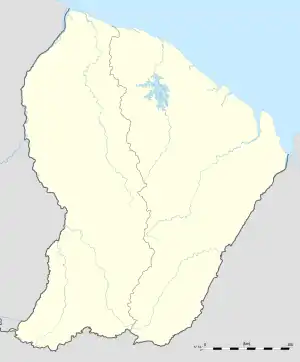Sainte-Rose-de-Lima | |
|---|---|
Village | |
 Sainte-Rose-de-Lima Location in French Guiana | |
| Coordinates: 4°49′59″N 52°20′10″W / 4.83305°N 52.33622°W | |
| Country | France |
| Overseas region | French Guiana |
| Arrondissement | Cayenne |
| Commune | Matoury |
| Established | 1971[1] |
| Government | |
| • Captain | Charles Wingaarde[2] |
| Population | |
| • Total | 500 |
Sainte-Rose-de-Lima is a village of Lokono[4] Amerindians in the commune of Matoury in French Guiana. The village is located on the RN2 near Cayenne – Félix Eboué Airport. It is the largest settlement of Lokono in French Guiana.[3]
History
In 1951, Lokono from Suriname started to migrate to French Guiana mainly for economic reasons.[3] The main villages of origin were Alfonsdorp near the Maroni River, and Matta in the Para District.[5] At first they settled in the existing Lokono village of Balaté near Saint-Laurent-du-Maroni.[6] Later, some migrated to Iracoubo and Cayenne often settling among the Kalina people.[3]
On 13 April 1969, a small plane carrying four people took off from Cayenne – Félix Eboué Airport in bad weather. It struck the tree tops, and crashed in the rainforest. There were no survivors.[7] In order to prevent future accidents, the rainforest in front of the runaway was cleared.[3] In 1971,[1] the Lokono created a settlement in the cleared area. Originally it was called "CD5" after the road running along the village.[3] The Catholic Church built a mission in the village.[8] In 1980, the priest of Matoury, suggested renaming the village "Sainte-Rose-de-Lima" after Rose of Lima.[3]
Sainte-Rose-de-Lima has received access to drinking water and electricity. The land is legally owned by the tribe,[3] and the tribal government is recognized by French Guiana.[9] However, the commune of Matoury refuses building permits citing safety and noise concerns.[3] Other shanty towns, mainly populated by Surinamese Maroons and Brazilians, have been constructed adjacent to Sainte-Rose-de-Lima. In 2020, INSEE counted five shanty towns in the commune.[10]
In 2008, the Federation of Lokono in French Guiana was established and is headquartered in Sainte-Rose-de-Lima.[11] In 1993, the Lokono had been awarded four hectares of communal land (ZDUC). In 2017, the land was controversially sold to a mining company.[12] In 2017, Sainte-Rose-de-Lima was host to the Grand Village, the meeting of all Amerindian tribal chiefs in French Guiana.[13] In June 2020, the village self isolated during the COVID-19 pandemic.[14]
See also
- Balaté, the other Lokono village in French Guiana
References
- 1 2 Grenard 1981, p. 3.
- ↑ "Coronavirus : Les villages amérindiens de Macouria et de Matoury s'isolent volontairement pour prévenir toute propagation du virus chez eux". France TV Info (in French). Retrieved 23 March 2021.
- 1 2 3 4 5 6 7 8 9 David Rodoreda. "St-Rose de Lima: une capitale pour les Arawak de Guyane". Une Saison en Guyane (in French). Retrieved 17 March 2021.
- ↑ "Elections à Balaté : la position de la FOAG". Blada (in French). Retrieved 17 March 2021.
- ↑ Grenard 1981, p. 11.
- ↑ Grenard 1981, p. 12.
- ↑ "Accident Piper PA-31-310 Navajo F-OBZS, 13 Apr 1969". Aviation Safety. Retrieved 17 March 2021.
- ↑ "Communion et confirmation à Sainte Rose de Lima". Catholique.fr (in French). 18 December 2019. Retrieved 17 March 2021.
- ↑ Grenard 1981, p. 13.
- ↑ "Concentration des difficultés dans les quartiers urbains périphériques et à Saint-Laurent-du-Maroni" (PDF). Blada (in French). December 2020. Retrieved 17 March 2021.
- ↑ "Fédération Lokono de Guyane". Blada (in French). Retrieved 17 March 2021.
- ↑ "Les zones de droit d'usage des Amérindiens : comprendre les attributions du foncier pour mieux le gérer (1/2)". France TV Info (in French). Retrieved 17 March 2021.
- ↑ "Les chefs coutumiers débattent du projet de la Montagne d'or". France TV Info (in French). Retrieved 17 March 2021.
- ↑ "La Guyane demande le report des municipales face à la multiplication des cas de Covid-19". Le Monde (in French). Retrieved 17 March 2021.
Bibliography
- Grenard, Pierre (1981). "La communauté Arawak de Sainte-Rose de Lima" (PDF). Cayenne: L'Office de la Recherche Scientifique et Technique Outre-Mer.